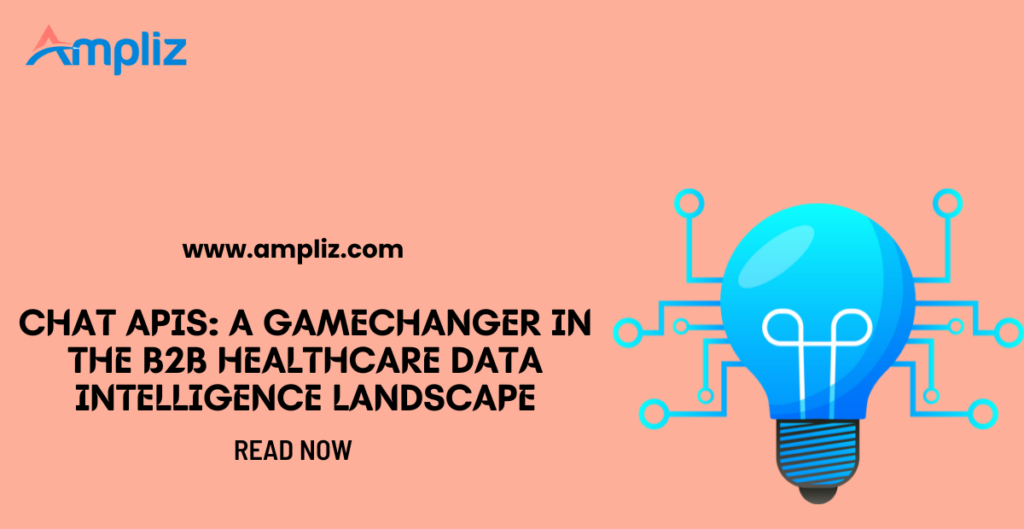As the world goes digital, healthcare is no exception. Amongst the many technological advancements permeating this sector, chat APIs stand out for their transformative potential in connecting businesses and streamlining operations.
This multi-faceted tool’s role within the B2B healthcare data intelligence ecosystem cannot be underestimated, and deserves a thorough exploration, so let’s do just that.
Understanding the Basics: What are Chat APIs?
First up, it’s essential to grasp what a chat API is. Essentially, an Application Programming Interface (API) for chat functions as a bridge between different software applications. It allows these diverse systems to communicate and interact with one another fluidly. In simpler terms, think of it as the secret language that your programs use to have ‘conversations’.
Within the healthcare sector, these tools can drastically increase efficiency by seamlessly integrating distinct systems which might normally be incapable of interfacing with one another. There are many places to find them, and as such, understanding their role and functionality forms the foundational step towards appreciating how they’re reshaping B2B healthcare data intelligence.
Chat APIs: Revolutionizing B2B Medical Data Management
The emergence of chat APIs has brought significant change to the world of B2B healthcare communication. These potent tools are redefining how data is managed, exchanged, and implemented in decision-making processes. Let’s consider some key areas:
Seamless Integration: Companies can share crucial information seamlessly due to the ‘bridge’ functionality offered by chat APIs, thus boosting operational efficiency.
Automation Capabilities: No more spending hours coordinating between software applications or manually entering data, as these tools automate routine tasks and promote precision.
Fostering Real-Time Collaboration: Whether it’s between laboratories and research facilities or insurance companies and hospitals, chat API-engineered platforms facilitate real-time dialogues that speed-up and improve overall service delivery.
Reflecting on these advantages underscores why chat APIs have become an indispensable part of successful B2B interactions within the multifaceted healthcare landscape.
The Rise of In-App Chat Support in Healthcare
In the field of B2B healthcare operations, in-app chat support from Sendbird and other API providers is making waves. Specially designed for seamless integration and interaction between businesses, here’s how they are pushing things forward:
Instant Assistance: In-app chat support enables intuitive dialogue between varying entities within healthcare networks, so app users don’t have to wait for a long time to get the assistance they need if something goes awry.
Sufficient Security: By keeping communication in-app, you avoid a lot of the vulnerabilities which might otherwise arise when implementing a third party platform alongside an established in-house app. This ensures compliance with data regulations, and also gives collaborators and clients confidence in your operations.
Seamless Integration: Using flexible APIs, these systems easily blend with existing infrastructures, augmenting overall efficiency without significant alterations or disruptions.
The evolution of sophisticated tools for real-time information exchange marks an exciting era ahead for B2B support and collaboration in the complex landscape that is healthcare data intelligence.
Advanced Features of Modern Chat APIs in Healthcare Data Intelligence
Chat APIs are evolving with striking features tailored towards enhancing B2B healthcare data intelligence. The following are some key aspects to consider:
Scalability: These systems can expand or shrink according to volume and need, thus preventing allocation inefficiencies or waste. Using a robust API management platform helps manage this scalability more effectively, ensuring that the API can handle increased loads without compromising performance.
24/7 Availability: Ensuring uninterrupted services even during peak usage times.
Customization: Chat APIs now come with a high level of customization. This allows for each B2B interaction to be tailor-made suiting exact needs, preferences or specific use-cases.
Automated Workflows: Another key feature is the ability to automate repetitive processes, increasing productivity and lessening the likelihood of human error in data transmission.
Versatility: One of the most compelling aspects is their adaptability. They can accommodate various formats, protocols and standards, making them compatible with a wide range of systems.
Embedded Analytics: Additionally, modern chat APIs are now offering built-in analytical tools to help businesses map out communication data trends, usage patterns, and other meaningful metrics.
The new wave of innovations is enriching the possibilities within the realm of healthcare data intelligence. It demonstrates that such tools aren’t just elements of convenience, but pillars for growth and prosperity in this field moving forward.
Overcoming Challenges with Implementing Chat APIs
While chat APIs undoubtedly offer enormous benefits, it’s also worth acknowledging the challenges that may arise during their implementation. Here are key obstacles to consider and the solutions:
Integration Hassle: Ensuring new systems align seamlessly with existing software can be tough. A potential solution is opting for APIs that support a broad spectrum of protocols.
Privacy Concerns: Sensitive health data passing through multiple systems creates privacy concerns. To overcome this, compliance with regulatory standards such as HIPAA or GDPR must be ensured when choosing an API provider.
Technical Expertise Requirement: Employees might need training to use these new applications effectively. Regular skill development workshops and user-friendly system designs could address this issue.
Awareness of these hurdles aids in devising proactive strategies ensuring smooth transition towards technologically advanced healthcare operations.
Wrapping Up
As you now know, chat APIs are fundamentally shifting B2B healthcare data intelligence dynamics. Embracing this technology is imperative for businesses aiming to thrive in the modern digital health arena.



